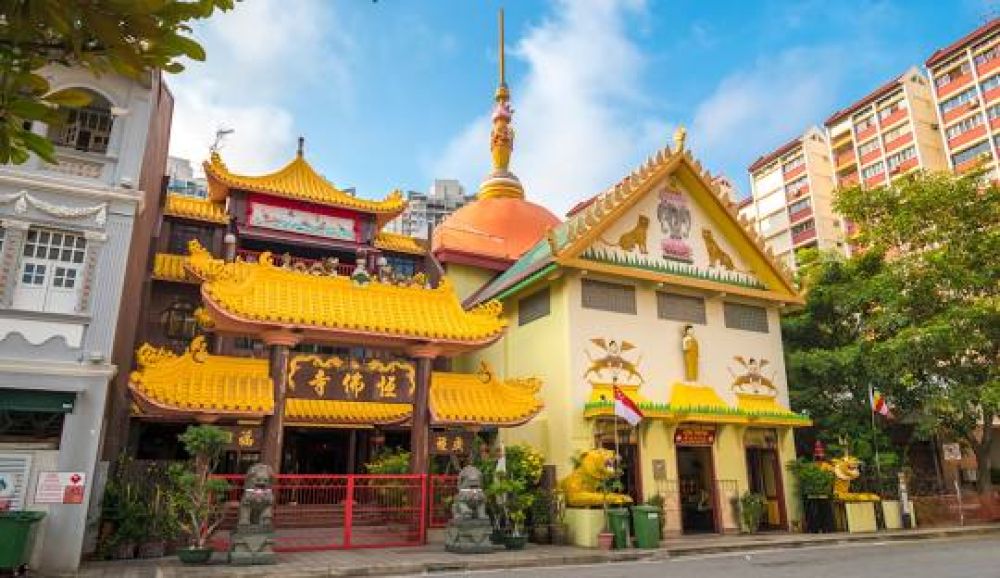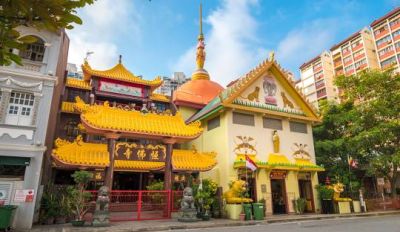

Embark on a guided tour of Sakya Muni Buddha Gaya Temple, also known as the Temple of 1,000 Lights, located in the cultural enclave of Little India in Singapore. As you step inside, you will be greeted by the serene and awe-inspiring ambiance of this sacred place. A knowledgeable guide will lead you through the temple, explaining the rich heritage of Thai Buddhism represented here and the significance of the impressive 15-meter high seated Buddha, which is surrounded by hundreds of small, flickering lights. The tour typically covers the temple's history, the story behind its founding by Venerable Vutthisasara, the architectural style, and the religious artifacts within. Participants will also learn about the daily rituals and ceremonies that take place, providing insight into the local Buddhist culture and practices.
The Sakya Muni Buddha Gaya Temple offers peaceful meditation sessions to visitors seeking a spiritual experience or a respite from the bustling city life. As you sit in the hall beneath the humbling presence of the massive Buddha statue, a facilitator will guide you through the principles of Buddhist meditation. These sessions typically include instruction on mindfulness and concentration, encouraging participants to focus on their breath and present moment awareness. It's a profound way to connect with the essence of Buddhist teachings, cultivate inner peace, and gain a deeper understanding of the mind. Whether you are an experienced practitioner or new to meditation, these sessions can help foster a state of tranquility and clarity.
Participate in the vibrant cultural festivities and celebrations that take place at Sakya Muni Buddha Gaya Temple during significant Buddhist holidays such as Vesak Day. This sacred day commemorates the birth, enlightenment, and death of the Buddha, and the temple comes alive with devotional activities. Visitors can witness and join in traditional ceremonies, chanting, and offerings. The temple is beautifully decorated, and the air is filled with a sense of reverence. These festivities provide a fantastic opportunity for cultural immersion and to observe the devotion of the Buddhist community. You will experience the temple in its most jubilant state, replete with lights, sounds, and the collective energy of the celebrants.
The Temple of 1,000 Lights regularly hosts Dharma talks, providing a deeper dive into Buddhist philosophy, ethics, and teachings. These talks are delivered by respected monks, nuns, and lay teachers. They often revolve around practical applications of Buddhist knowledge for overcoming life's challenges, cultivating compassion, and developing wisdom. Dharma talks can be an enlightening experience for visitors looking to understand more about Buddhism, and they often include a Q&A session where participants can engage with the speaker and ask questions about their spiritual journey. Attending a Dharma talk is not only educational but may also offer life-changing perspectives and personal growth.
For those with a keen interest in Buddhist literature, the temple offers a collection of books for browsing and reading on-site. The selection covers various aspects of Buddhism, including scriptures, commentary, meditation guides, and contemporary applications of Buddhist thought. This quiet activity provides a chance to delve into the written wisdom passed down through generations. You can spend time absorbing teachings at your own pace, finding inspiration or solace in the pages. This is a self-guided activity and can be particularly fulfilling for those with a profound interest in spiritual learning and growth.
Visiting Sakya Muni Buddha Gaya Temple allows for the unique opportunity to observe Buddhist rituals performed by the monks. This can include daily practices such as the morning and evening puja (worship), which involves chanting, drumming, and the making of offerings to the Buddha. These rituals hold great significance and are carried out with deep respect and devotion. Observing them can be a moving experience, offering insight into the spiritual discipline and the daily lives of the temple's monastic residents. Visitors are welcome to watch these rituals in silence and must be dressed appropriately to maintain the sanctity of the temple environment.
Engage with the community through volunteer opportunities offered by the Temple of 1,000 Lights. Activities may include assisting with temple maintenance, participating in charitable events, or aiding in the preparation and distribution of food to the less fortunate. This is a chance to practice selflessness and compassion in line with Buddhist principles, while also making meaningful connections with others. Volunteers gain a sense of fulfillment and perspective by contributing their time and energy to the temple and its social initiatives. Prior arrangement with temple authorities is typically required, and such acts of service are often seen as a form of merit-making in Buddhist tradition.
Take the time to appreciate the art and architecture of the Temple of 1,000 Lights, which showcases a blend of Thai and Chinese influences. Visitors can admire the intricate details of the temple's facade, carvings, and statues that adorn the site. The highlight is the large, illuminated Buddha statue that gives the temple its name, but there are also numerous other figures and frescoes depicting Buddhist legends and stories. Informational placards provide context about the symbolism and significance of various architectural elements, allowing visitors to gain a deeper understanding of the cultural and religious heritage reflected in the temple's design.
Photography enthusiasts will find the Temple of 1,000 Lights to be a captivating subject. The temple's grand statue of the Buddha, ornate decorations, and ambient lighting create a memorable tableau for both amateur and professional photographers. While capturing the beauty and serenity of the temple, photographers must be mindful of cultural sensitivities and adhere to any guidelines set by the temple authorities. It is important to respect the sacred spaces and the worshippers, avoiding any disruption to the temple activities. The resulting photographs can be cherished as a visual souvenir of your visit to this picturesque and spiritual landmark.
The temple's gift shop offers a wide array of souvenirs, religious artifacts, and books. Exploring the shop allows visitors to find keepsakes that commemorate their visit or gifts that carry spiritual significance. Items often include prayer beads, Buddha statues, incense, and traditional Thai and Buddhist decorations. Proceeds from the gift shop typically support the maintenance and activities of the temple, so purchases here can also be considered as contributing to the upkeep of this important cultural and religious site. The selection is curated to represent elements of the teachings and artistry relevant to the temple's heritage.
